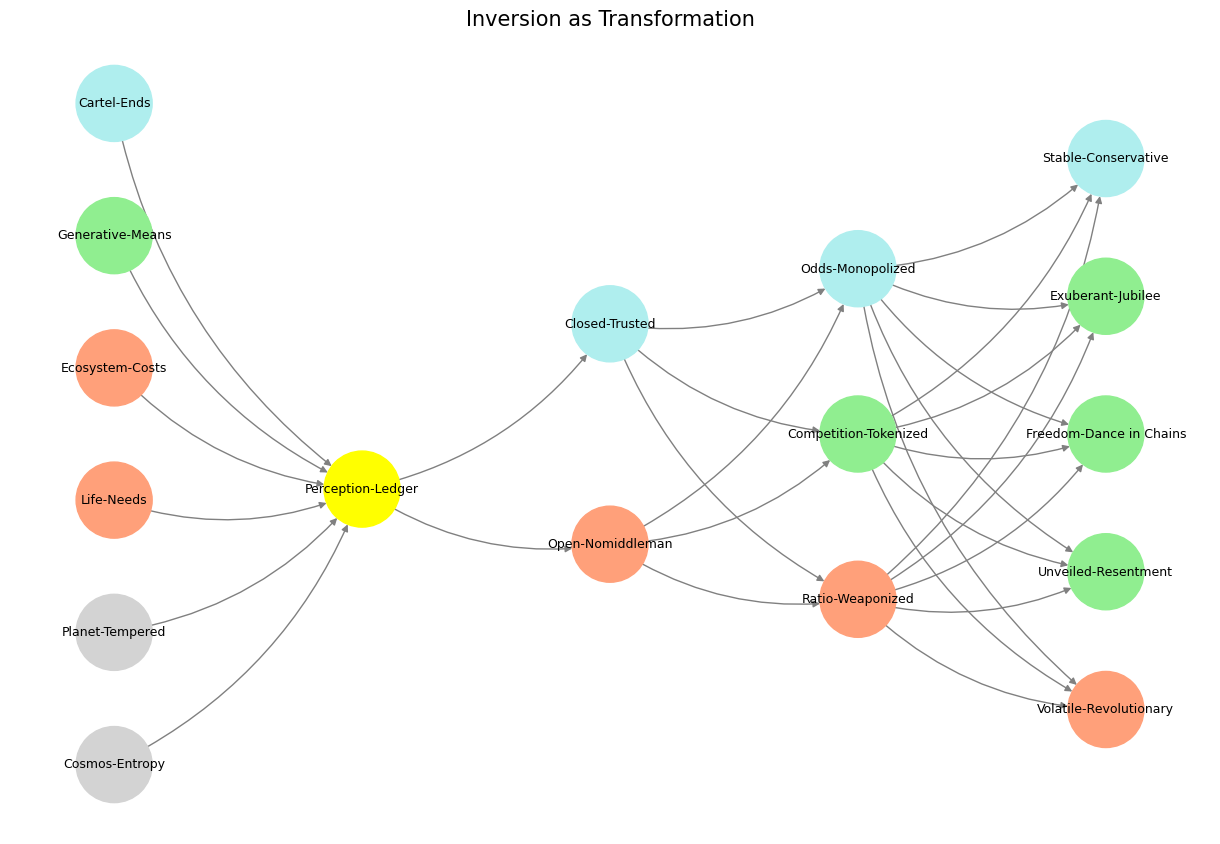Anchor ⚓️#
The neural network we outline below captures a layered understanding of human systems, with each layer representing a critical dimension of reality: world, perception, agency, generative processes, and physical manifestation. It operates as a fractal of interdependent dynamics, embodying metaphysical principles, societal constructs, and individual action. Each node is a philosophical anchor that reflects the immutable laws governing its respective domain—be they cosmic, human, or technological. Let’s unpack these layers.

Fig. 4 Strategic Ambiguity. The Red Queen presents rather fascinating scenarios to us.#
At the World layer, we find the foundational forces—cosmos, planet, and ecosystem—interacting through metaphysical categories like theomachy, mortals, and fire. This layer contextualizes reality as shaped by immutable energies. For instance, Prometheus’s fire, a metaphor for technological advancement, represents the dual-edged nature of human progress: a tool for creation but also for destruction. Within this layer, there is a constant negotiation between entropy (chaos) and temperance (order), echoed in the tension between generative means and cartel ends. This duality is mirrored in historical patterns, such as the exploitation of resources for monopolistic gain versus their cooperative, life-sustaining potential.
The Perception layer, represented by the yellow node, raises the metaphysical question: are we perceiving the world accurately, or are we trapped within simulations or inversions of reality? This layer is the moral compass that must validate whether what is observed aligns with the immutable laws of the gods, mortals, and technology. It is the philosophical heart of the network, scrutinizing the coherence between perception and the underlying truth. A failure here introduces dissonance, leading to questions of authenticity and trust.
Next, the Agency layer grapples with whether systems are open or closed, exposing the moral and ethical stakes of human action. An open system—marked by the absence of intermediaries—can be seen as honest and decentralized, while a closed, trusted system may either provide stability or mask fraud. This distinction recalls the tension between Oscar Wilde’s deliberate artistic inversions and Sam Bankman-Fried’s fraudulent simulations. Wilde’s art is an honest subversion, inviting complicity through humor and satire, while FTX’s tokens were an elaborate deception, engineering trust where none was warranted. Agency, therefore, operates at the intersection of ethics and manipulation, where individuals either declare their intent openly or obscure it behind façades.
The Generative layer delves into the dynamics of creation—whether ideas, resources, or societal systems. This layer encompasses tokenization, weaponization, and monopolization, reflecting the commodification of human creativity and effort. Tokens, in this context, can either be empowering tools for participation (as in Wilde’s plays, where aristocrats become complicit in the ridicule) or hollow constructs, as seen in FTX’s NFTs. The generative process here is ethically agnostic; its value depends on how tokens are deployed—whether for emancipation or exploitation.
Finally, the Physical layer embodies the tangible outcomes of these interconnected processes, manifesting as values, behaviors, and societal states. From volatile revolutionaries to conservative stability, this layer reflects the range of human responses to systemic dynamics. For instance, Wilde’s Victorian audience, complicit in his satire, occupies the stable-conservative node, finding jubilance in their cultural self-awareness. Conversely, unveiled resentment and revolutionary volatility arise when the dissonance between perception and reality becomes unbearable.
The network, as a whole, offers a framework to interrogate ethical systems, historical dynamics, and human action. By anchoring perception in immutable laws, it challenges us to discern authenticity from artifice. It also critiques how agency and generative processes interact, emphasizing the thin line between creation and deception. Ultimately, the network’s output—manifest in physical and societal systems—depends on the ethical clarity and coherence of the layers preceding it. Through this lens, we are invited to engage with art, ethics, and technology as interconnected domains, each demanding rigorous scrutiny and deliberate choice.
Show code cell source
import numpy as np
import matplotlib.pyplot as plt
import networkx as nx
# Define the neural network fractal
def define_layers():
return {
'World': ['Cosmos-Entropy', 'Planet-Tempered', 'Life-Needs', 'Ecosystem-Costs', 'Generative-Means', 'Cartel-Ends', ], # Theomarchy, Mortals, Fire
'Perception': ['Perception-Ledger'], # God
'Agency': ['Open-Nomiddleman', 'Closed-Trusted'], # Evil & Good
'Generative': ['Ratio-Weaponized', 'Competition-Tokenized', 'Odds-Monopolized'], # Dynamics, Compromises
'Physical': ['Volatile-Revolutionary', 'Unveiled-Resentment', 'Freedom-Dance in Chains', 'Exuberant-Jubilee', 'Stable-Conservative'] # Values
}
# Assign colors to nodes
def assign_colors():
color_map = {
'yellow': ['Perception-Ledger'], # , Judgement Day, Key
'paleturquoise': ['Cartel-Ends', 'Closed-Trusted', 'Odds-Monopolized', 'Stable-Conservative'], # Slavery, Colonialism, Worker
'lightgreen': ['Generative-Means', 'Competition-Tokenized', 'Exuberant-Jubilee', 'Freedom-Dance in Chains', 'Unveiled-Resentment'], # Das Kapital, Frankenstein, AI
'lightsalmon': [
'Life-Needs', 'Ecosystem-Costs', 'Open-Nomiddleman', # Ecosystem = Red Queen = Prometheus = Sacrifice
'Ratio-Weaponized', 'Volatile-Revolutionary'
],
}
return {node: color for color, nodes in color_map.items() for node in nodes}
# Calculate positions for nodes
def calculate_positions(layer, x_offset):
y_positions = np.linspace(-len(layer) / 2, len(layer) / 2, len(layer))
return [(x_offset, y) for y in y_positions]
# Create and visualize the neural network graph
def visualize_nn():
layers = define_layers()
colors = assign_colors()
G = nx.DiGraph()
pos = {}
node_colors = []
# Add nodes and assign positions
for i, (layer_name, nodes) in enumerate(layers.items()):
positions = calculate_positions(nodes, x_offset=i * 2)
for node, position in zip(nodes, positions):
G.add_node(node, layer=layer_name)
pos[node] = position
node_colors.append(colors.get(node, 'lightgray')) # Default color fallback
# Add edges (automated for consecutive layers)
layer_names = list(layers.keys())
for i in range(len(layer_names) - 1):
source_layer, target_layer = layer_names[i], layer_names[i + 1]
for source in layers[source_layer]:
for target in layers[target_layer]:
G.add_edge(source, target)
# Draw the graph
plt.figure(figsize=(12, 8))
nx.draw(
G, pos, with_labels=True, node_color=node_colors, edge_color='gray',
node_size=3000, font_size=9, connectionstyle="arc3,rad=0.2"
)
plt.title("Inversion as Transformation", fontsize=15)
plt.show()
# Run the visualization
visualize_nn()


Fig. 5 How now, how now? What say the citizens? Now, by the holy mother of our Lord, The citizens are mum, say not a word.#

